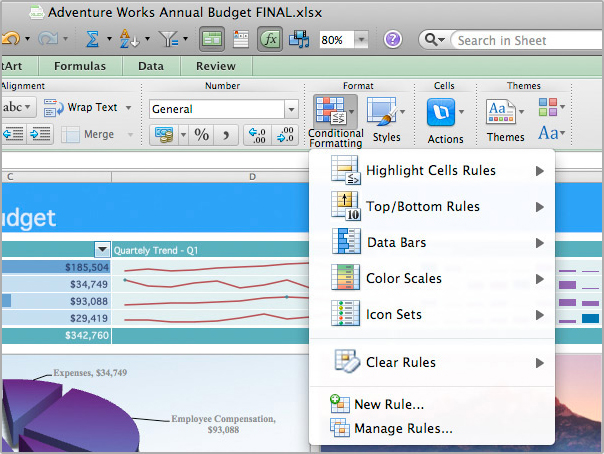
#Folumla bar in excel for mac how to#
I'm adding this after following a link from a Tip about how to view full contents of a cell with a great deal of text. So it improved my technique just by existing and being known.Īgain, no help to those who want them to un-expand automatically, but perhaps of interest to those who'd like to have the use of it. or two) so the changeable pieces are right at the beginning for a user to find quickly. Also led me to put the changeable portions of them on the first line (usually. It's been hugely helpful to me, especially the way I like to give my LET()'s a formal structure to make parsing them later easier. Mentioned it on a website and found the Excel MVP's had known about it for decades and never thought anyone did not know about it. Later I saw the two-headed border arrow and experimented. I came across it a couple years back very much by accident and didn't realize it had happened, just thought Excel had listened (for once) and expanded it in the monthly upgrade. He'll never figure out why he never can get the expanded three lines. If you've a pranky mind, expand a co-worker's formula editor and pull it up to one line, then un-expand. It sticks, so if you want to return to the standard three line expanded view, you have to do it by hand. Also great for formal structure to enhance one's use of IFS() and related things, even IF() if one has nested many of them. Want 25 lines for viewing your formula? Nice when using LET() and a formal structuring and I bet even nicer when LAMBDA reaches us hoi polloi. That's lost just as suddenly, so it's a wee bit fiddly, but when you have it, and that happens when its top head is 1-2mm from the border, you can click down and drag the border down, or up, as many rows as you wish. As it reaches the bottom of the white formula bar region, and begins to go overtop the gray that is above the column headings (the column heading divisions only extend partly up to the white region so you could think of it as the hovering mouse reaching the gray bar above the headings, but it's truly just a roof, so to speak), the mouse will suddenly turn into a version of the up/down two-headed arrow one associates with MS's border moving indicator (especially that of Word, though rather different, so "associates with"). Then hover your mouse over it and slowly move down. (or don't, so it's always expanded and adjust to suit as desired). No help to those who want it to expand - AND contract - automatically, but is definitely of help to those writing formulas that are more than the expansion's three lines.Įxpand it, so this only takes place when expanded, not when you want the single line.

The Display section of the Advanced options in the Excel Options dialog box.

In Excel 2010 and later versions, display the File tab of the ribbon and then click Options.) (In Excel 2007 click the Office button and then click Excel Options. (If you have no Formula bar displayed, then it cannot expand and obscure information in the worksheet.) If you want to turn off the Formula bar completely, follow these steps:

When you hover the mouse pointer over the tool, the ToolTip says "Expand Formula Bar." (In Excel 2013 and later versions, it'll be the small arrow icon that expands the formula bar.)Īnother option is to simply turn off the Formula bar completely. To expand the Formula bar (so you can see everything it contains), click the tool at the very right edge of the Formula bar. That way it will always take a specific amount of space and you won't be bothered by it jumping around as much. The first is to make the size of the Formula bar static and the other is to turn off the Formula bar completely.Įxcel allows you to modify the number of lines used by the Formula bar. If the Formula bar takes up two or three lines of depth, it overlays the column headers and other cells in the worksheet. The problem with an automatically adjusting Formula bar is that it can obscure other elements on the screen.

When you move to another cell, the Formula bar again decreases in depth to a single line. If the contents are longer than what can be displayed in a single line on the Formula bar, the depth of the Formula bar increases so that the entire formula can be displayed. When you select a cell in a worksheet, the contents of that cell are shown in the Formula bar.


 0 kommentar(er)
0 kommentar(er)
